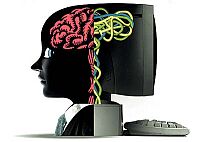Grey
matter, blue matter
by F. David Peat
 The
first serious attempt to build a computer model of the brain has just
begun.
The
first serious attempt to build a computer model of the brain has just
begun.
The most complex object known to humanity is the human brain—and not only is it complex, but it is the seat of one of the few natural phenomena that science has no purchase on at all, namely consciousness. To try to replicate something that is so poorly understood may therefore seem like hubris. But you have to start somewhere, and IBM and the Ecole Polytechnique Fédérale de Lausanne (EPFL), in Switzerland, propose to start by replicating “in silico”, one of the brain's building blocks.
The two organisations said they would be working together to build a simulation of a structure known as a neocortical column on a type of IBM supercomputer that is currently used to study the molecular functioning of genes. If that works, they plan to use future, more powerful computers to link such simulated columns together into something that mimics a brain.
Assuming that the growth of computing power continues to follow Moore's Law, Charles Peck, the leader of IBM's side of the collaboration, reckons it should be feasible to emulate an entire human brain in silico in ten to 15 years. Such an artificial brain would be a powerful research tool. The researchers hope that their simulated brain will reveal the secrets of how certain psychiatric and neurological disorders develop. But that is probably not the real reason for doing it. The most interesting questions are whether such an artificial brain will be intelligent, or conscious, or both.
Some academics, such as Roger Penrose of Oxford University, argue that brains do not work in a way comparable with a computer, so any kind of simulation that is built on digital architecture and uses traditional programming techniques is doomed to failure. Dr. Penrose thinks that exotic quantum processes are involved in the generation of consciousness. The “Blue Brain” project will help to determine whether he is right or wrong.
Henry Markram, the boss of the Brain Mind Institute, and the leader of the EPFL's side of the collaboration, stresses that the goal is not to build an artificial intelligence system, such as a neural network. Nor is it to create a conscious machine.
The goal is merely to build a simulacrum of a biological brain. On the other hand, he also says, “I believe the intelligence that is going to emerge if we succeed in doing that is going to be far more than we can even imagine.”
excerpt from www.economist.com/science, 6/9/05